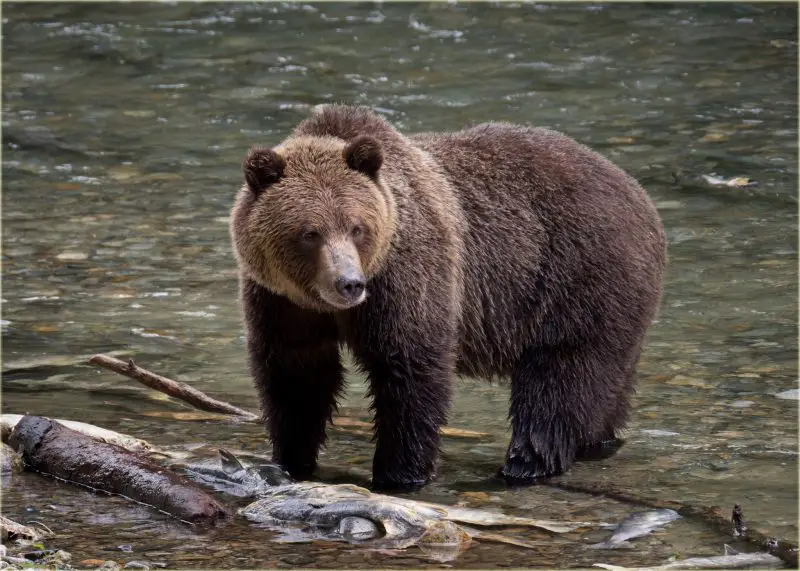Montana’s wild and scenic landscapes are home to two remarkable species of bears that roam its forests, mountains, and valleys. From Glacier National Park in the north to the Greater Yellowstone region in the south, these powerful animals are an integral part of the state’s natural heritage. Their presence is a reminder of Montana’s untamed wilderness and the need for respectful coexistence with nature.
Bears in Montana are not only awe-inspiring to observe but also vital to the health of their ecosystems. They help control animal populations, spread seeds, and even shape the landscape through their foraging behavior. Understanding how these bears live, what they eat, and how they interact with their environment can deepen your appreciation for Montana’s wildlife.
This article explores the two species of bears in Montana—the American Black Bear and the Grizzly Bear. You’ll discover their identifying features, behaviors, preferred habitats, and where each is commonly found across the state. Learning these details can enhance your outdoor experiences and promote safe, responsible wildlife encounters.
Common Bears Found in Montana
American Black Bear (Ursus americanus)

The American Black Bear is the most common and widespread bear species in North America and is frequently encountered in Montana’s forested regions. Despite the name, not all black bears are actually black—individuals may appear in a variety of colors including brown, cinnamon, blond, or even bluish-black. These bears are medium-sized, with adult males typically weighing between 200 and 600 pounds, while females average 100 to 300 pounds. Their bodies are more slender than grizzlies, with a straight facial profile, tall pointed ears, and no noticeable shoulder hump, which helps distinguish them in the wild.
Black bears are intelligent, solitary, and generally non-aggressive unless threatened or when a mother is defending her cubs. They are highly adaptable and excellent climbers, often escaping danger or seeking food in treetops. In Montana, they are active from spring through late fall, hibernating during the winter in dens constructed under logs, in hollow trees, or within caves. They are known for their keen sense of smell, which they use to locate food from great distances.
Their diet is omnivorous and highly varied, changing with the seasons. In spring, they feed on fresh grasses, shoots, and insects; summer brings berries and fruits; while autumn is the time to fatten up with nuts, roots, and whatever high-calorie food they can find. They are also opportunistic scavengers and occasionally prey on small mammals or young deer. Human-provided food or garbage can unfortunately attract them to populated areas, especially in campsites and rural communities.
In Montana, black bears are commonly found in western and central parts of the state, especially in areas such as the Bitterroot Mountains, Bob Marshall Wilderness, and Glacier National Park. They prefer dense forests, riparian zones, and mixed coniferous woodlands but are also comfortable in open meadows and mountainous terrain. While their populations are stable, responsible recreation and food storage are crucial in minimizing human-bear conflicts.
Grizzly Bear (Ursus arctos horribilis)

The Grizzly Bear, a subspecies of the brown bear, is one of the most iconic and powerful predators of North America. In Montana, grizzlies are found mainly in and around Glacier National Park, the Greater Yellowstone Ecosystem, and remote wilderness areas such as the Bob Marshall Wilderness Complex. Adult males can weigh between 400 and 800 pounds or more, while females range from 250 to 450 pounds. One of their most distinctive features is the large muscular hump over their shoulders, used for digging. They also have a concave facial profile, short rounded ears, and long, curved claws ideal for excavating roots or animal burrows.
Grizzly bears are generally solitary, except for females with cubs or during breeding season. They are less agile climbers than black bears but can run surprisingly fast—up to 35 miles per hour for short distances. While often misunderstood as overly aggressive, grizzlies are more defensive than predatory and prefer to avoid humans. However, they can be dangerous when surprised, or when guarding food or offspring. Proper precautions and knowledge are essential when recreating in grizzly country.
Their diet is omnivorous, with significant regional and seasonal variation. Grizzlies in Montana eat grasses, roots, berries, and insects in spring and summer. In late summer and fall, they feed heavily on whitebark pine nuts, army cutworm moths, and meat from carrion or live prey such as deer or elk. In areas around Yellowstone, they are known to scavenge from wolf kills and may compete with other large predators. Unlike polar bears, grizzlies are not dependent on meat and thrive on high-calorie vegetation when available.
Grizzly bears once roamed across much of the western U.S., but today they are limited to a few core habitats. In Montana, they are concentrated in two main populations: one in the Northern Continental Divide Ecosystem (around Glacier National Park), and one in the Greater Yellowstone Ecosystem in the south. Efforts by wildlife agencies have helped stabilize and slowly increase their numbers, though they remain listed as a threatened species under the Endangered Species Act. Their survival depends on large, undisturbed tracts of wilderness and responsible human behavior in shared landscapes.
Comparing Black Bears and Grizzly Bears
Key Differences in Appearance
One of the most noticeable differences between black bears and grizzly bears lies in their physical build and markings. Black bears typically have a straight facial profile with tall, pointed ears and no prominent shoulder hump. Their fur color ranges widely—from jet black to brown, cinnamon, or even blonde—making color alone an unreliable identifier. In contrast, grizzly bears have a distinctive muscular shoulder hump, a concave or “dished” facial profile, and shorter, rounded ears. Their fur tends to be brown but often has lighter tips, giving a grizzled or “silver-tipped” appearance, which inspired the name “grizzly.” Additionally, grizzlies possess longer, thicker claws adapted for digging, whereas black bears have shorter, more curved claws suited for climbing.
Differences in Behavior and Temperament
Behaviorally, black bears are more agile and excellent climbers, often seeking refuge in trees when threatened. They tend to be more cautious and avoid human interaction when possible. Grizzly bears, while capable of running fast and strong, are less adept climbers and rely more on their size and strength for defense. They can be more territorial and assertive, especially females with cubs or during mating season. Both species are generally omnivorous, but grizzlies have a greater tendency to consume meat, including scavenging and hunting, while black bears often rely more heavily on vegetation and insects. Understanding these differences is crucial for anyone venturing into bear country, as it helps in predicting bear behavior and reacting safely.
Habitat Overlaps and Preferences
Although black bears and grizzly bears share overlapping ranges in Montana, their habitat preferences can differ. Black bears are more adaptable and can thrive in a variety of environments, from dense forests and riparian zones to lower elevation foothills. Grizzlies favor more remote, rugged terrain such as alpine meadows, subalpine forests, and open valleys where large prey and nuts like whitebark pine are abundant. In Montana, grizzlies are primarily found in the northern Rockies and Greater Yellowstone ecosystem, whereas black bears occupy a wider area throughout the western and central parts of the state. Despite these preferences, areas of habitat overlap do exist, particularly in transition zones where food sources and cover are plentiful.
Where to See Bears in Montana
Popular Locations for Bear Watching
Montana offers several prime locations for observing bears in their natural habitat. Glacier National Park is renowned for both black and grizzly bears, with vast wilderness areas that support healthy populations. The Greater Yellowstone Ecosystem, spanning southern Montana, is another hotspot where grizzlies are commonly seen, especially near Yellowstone and Grand Teton National Parks. The Bob Marshall Wilderness Complex and the Selway-Bitterroot region provide excellent opportunities for black bear sightings in more remote settings. Wildlife refuges, national forests, and designated bear viewing areas across the state also attract enthusiasts hoping to catch a glimpse of these magnificent animals.
Best Seasons and Times for Sightings
The best time to see bears in Montana is typically from late spring through early fall. During this period, bears are most active, foraging extensively to build fat reserves for winter hibernation. Early summer is ideal for spotting black bears feeding on fresh vegetation and insects, while late summer and early fall increase the chances of seeing grizzlies feeding on high-calorie foods like pine nuts and berries. Dawn and dusk are generally the most active times of day for bears, as they avoid the heat and human activity common in midday. Winter months see bears in hibernation, making sightings very rare.
Responsible Wildlife Viewing Practices
When watching bears in the wild, safety and respect for the animals are paramount. Observers should maintain a safe distance—at least 300 yards for grizzlies and 100 yards for black bears—to avoid disturbing them or provoking defensive behavior. Use binoculars or zoom lenses for close-up views rather than approaching. Never feed bears or leave food unsecured, as this can lead to dangerous habituation. Stay alert, make noise while hiking to avoid surprising bears, and always carry bear spray when in bear country. Following Leave No Trace principles helps preserve the natural behavior and habitat of Montana’s bears for generations to come.
Conservation Status and Efforts
Current Population Trends
Montana’s bear populations have shown signs of recovery due to decades of conservation efforts, hunting regulations, and habitat protection. Black bears are widespread and relatively stable, with healthy numbers throughout much of the state. Grizzly bears, once on the brink of local extinction in the lower 48 states, have made a gradual comeback in the Northern Continental Divide and Greater Yellowstone ecosystems. However, their populations remain limited compared to historical levels and are closely monitored by wildlife agencies.
Threats Facing Bears in Montana
Despite progress, bears in Montana face ongoing threats from habitat fragmentation, human-wildlife conflicts, and climate change. Expanding roads, urban development, and resource extraction reduce available habitat and increase encounters with people, often resulting in bear displacement or mortality. Illegal poaching and vehicle collisions also pose risks. Climate change affects food availability, altering bear foraging patterns and reproductive success. These challenges require continued vigilance and adaptive management.
Conservation Programs and How People Can Help
State and federal agencies work alongside conservation groups to protect bear habitats, implement conflict mitigation strategies, and conduct research on bear ecology. Public education campaigns emphasize safe living and recreation practices in bear country. People can contribute by supporting habitat conservation efforts, reporting bear sightings responsibly, and following guidelines for food storage and waste management in wilderness areas. Volunteer programs and citizen science initiatives offer additional ways for individuals to engage in Montana’s bear conservation.
Conclusion
Summary of Key Points
Montana is home to two remarkable bear species: the adaptable American Black Bear and the iconic, powerful Grizzly Bear. Both play essential roles in the state’s ecosystems and offer incredible opportunities for wildlife observation. Understanding their physical traits, behaviors, and habitats enhances appreciation and promotes safety for both humans and bears.
Encouragement to Respect and Protect Montana’s Bears
Protecting Montana’s bears means respecting their space and supporting conservation efforts. These animals are symbols of wilderness health and resilience, deserving our care and thoughtful stewardship. By living responsibly and raising awareness, we ensure that future generations can experience the wonder of bears roaming Montana’s wild places.
Final Tips for Safe and Enjoyable Outdoor Experiences
Always stay alert and maintain safe distances when in bear country. Carry bear spray, store food securely, and make your presence known on trails to reduce surprise encounters. Educate yourself about bear behavior and local regulations before heading outdoors. With respect and caution, enjoying Montana’s bear populations can be a rewarding and unforgettable experience.






